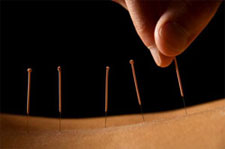
Scientists are also finding parallels between the ancient concepts and modern anatomy. Many of the 365 acupuncture points correspond to nerve bundles or muscle trigger points. Several meridians track major arteries and nerves. "If people have a heart attack, the pain will radiate up across the chest and down the left arm. That's where the heart meridian goes," says Peter Dorsher, a specialist in pain management and rehabilitation at the Mayo Clinic in Jacksonville, Fla. "Gallbladder pain will radiate to the right upper shoulder, just where the gallbladder meridian goes."
Many medical experts remain deeply skeptical about acupuncture, of course, and studies of its effectiveness have been mixed. "Something measurable is happening when you stick a needle into a patient—that doesn't impress me at all," says Edzard Ernst, a professor of complementary medicine at the University of Exeter in England and co-author of the book, "Trick or Treatment." Acupuncture "clearly has a very strong placebo effect. Whether it does anything else, the jury is still out."
Even so, the use of acupuncture continues to spread—often alongside conventional medicine. U.S. Navy, Air Force and Army doctors are using acupuncture to treat musculoskeletal problems, pain and stress in stateside hospitals and combat zones in Iraq and Afghanistan. Delegations from Acupuncturists Without Borders are holding communal ear-needling sessions to reduce stress among earthquake victims in Haiti. Major medical centers—from M.D. Anderson in Houston to Memorial Sloan-Kettering in New York—use acupuncture to counteract the side effects of chemotherapy.
In a 2007 survey, 3.2 million Americans had undergone acupuncture in the past year—up from 2.1 million in 2001, according to the government's National Center for Complementary and Alternative Medicine.
The most common uses are for chronic pain conditions like arthritis, lower back pain and headaches, as well as fatigue, anxiety and digestive problems, often when conventional medicine fails.
....read more